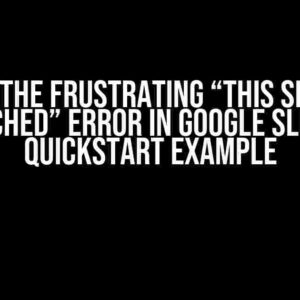Are you tired of getting stuck while trying to loop through an inner list of objects? Do you find yourself scratching your head, wondering how to access those pesky inner elements? Fear not, dear coder, for we’ve got you covered! In this comprehensive guide, we’ll take you by the hand and walk you through the process of looping through an inner list of objects like a pro.
What is an Inner List of Objects?
Before we dive into the nitty-gritty, let’s take a step back and define what an inner list of objects is. An inner list of objects is a data structure where a list contains objects, and each object has its own list or array of elements. Think of it like a Russian nesting doll – you’ve got a list, inside which you’ve got objects, and inside those objects, you’ve got more lists or arrays! It’s like a never-ending tunnel of awesomeness.
A Real-World Example
Imagine you’re building an e-commerce website, and you want to display a list of orders. Each order has a list of products, and each product has its own details like name, price, and quantity. You might have a data structure that looks like this:
orders = [
{
id: 1,
products: [
{ name: 'Product A', price: 10.99, quantity: 2 },
{ name: 'Product B', price: 5.99, quantity: 3 }
]
},
{
id: 2,
products: [
{ name: 'Product C', price: 7.99, quantity: 1 },
{ name: 'Product D', price: 3.99, quantity: 4 }
]
}
]
In this example, we’ve got an outer list of orders, and each order has an inner list of products. We want to loop through the orders and access the products within each order. That’s where the magic happens!
Why Do We Need to Loop Through an Inner List of Objects?
- Data Processing**: You might need to perform calculations or operations on the inner elements, like summing up the prices of all products in an order.
- Data Visualization**: You want to display the inner elements in a graphical format, like a chart or a table, to provide a better user experience.
How to Loop Through an Inner List of Objects
Now that we’ve covered the what and the why, let’s get to the good stuff! Here are a few ways to loop through an inner list of objects:
Method 1: Nested For Loops
The most straightforward way to loop through an inner list of objects is using nested for loops. Here’s an example:
for (let order of orders) {
for (let product of order.products) {
console.log(`Order ${order.id}: ${product.name} - ${product.price} x ${product.quantity}`);
}
}
This code will output:
Order 1: Product A - 10.99 x 2 Order 1: Product B - 5.99 x 3 Order 2: Product C - 7.99 x 1 Order 2: Product D - 3.99 x 4
Method 2: Using Array Methods (forEach, map, reduce)
Another way to loop through an inner list of objects is by using array methods like `forEach`, `map`, and `reduce`. Here’s an example using `forEach`:
orders.forEach(order => {
order.products.forEach(product => {
console.log(`Order ${order.id}: ${product.name} - ${product.price} x ${product.quantity}`);
});
});
This code will output the same result as the previous example.
Method 3: Using a Recursive Function
If you’re dealing with a deeply nested data structure, a recursive function might be the way to go. Here’s an example:
function loopThroughProducts(order) {
console.log(`Order ${order.id}:`);
order.products.forEach(product => {
console.log(` - ${product.name} - ${product.price} x ${product.quantity}`);
if (product.subProducts) {
loopThroughProducts(product);
}
});
}
orders.forEach(order => loopThroughProducts(order));
This code will recursively loop through the products and sub-products, displaying the details in a hierarchical format.
Common Pitfalls to Avoid
When looping through an inner list of objects, it’s easy to fall into common pitfalls. Here are a few mistakes to watch out for:
- Undefined or Null References**: Make sure to check if the inner list or objects are defined before trying to access them.
- Infinite Loops**: Be careful when using recursive functions, as they can lead to infinite loops if not implemented correctly.
- Data Mutations**: Avoid modifying the original data structure while looping through it, as this can lead to unexpected results.
Best Practices and Performance Optimization
When looping through an inner list of objects, it’s essential to follow best practices and optimize for performance. Here are a few tips:
- Use const and let**: Instead of using `var`, use `const` and `let` to declare variables, which helps with block scoping and reduces the risk of variable hoisting.
- Avoid Global Variables**: Declare variables within the scope of the loop to minimize the risk of global variable pollution.
- Use Array Methods**: When possible, use array methods like `forEach`, `map`, and `reduce` instead of for loops, as they are often more efficient and concise.
- Optimize Data Structures**: Consider optimizing your data structures to reduce the number of loops or iterations required.
Conclusion
Looping through an inner list of objects can be a daunting task, but with the right approach, it can be a breeze. In this article, we’ve covered the what, why, and how of looping through inner lists of objects, as well as common pitfalls to avoid and best practices to follow. Whether you’re a seasoned developer or a newbie, this guide should have provided you with the necessary tools and knowledge to tackle even the most complex data structures.
So, the next time you’re faced with an inner list of objects, remember: stay calm, stay patient, and loop like a pro!
| Method | Description | Example |
|---|---|---|
| Nested For Loops | Using nested for loops to iterate through the inner list | for (let order of orders) { for (let product of order.products) { ... } } |
| Array Methods | Using array methods like forEach, map, and reduce |
orders.forEach(order => { order.products.forEach(product => { ... }) }); |
| Recursive Function | Using a recursive function to loop through the inner list | function loopThroughProducts(order) { ... } |
Frequently Asked Questions
Are you tired of struggling to loop through inner lists of objects? Worry no more! Here are some frequently asked questions and answers to help you navigate this obstacle.
Q1: How do I loop through an inner list of objects in JavaScript?
You can use a nested loop to iterate through the inner list of objects. For example, if you have an array of objects with an inner list, you can use a `forEach` loop to iterate through the outer array, and then use another `forEach` loop to iterate through the inner list. Here’s an example:
“`
const OuterArray = [
{ id: 1, innerList: [{ name: ‘John’ }, { name: ‘Doe’ }] },
{ id: 2, innerList: [{ name: ‘Jane’ }, { name: ‘Smith’ }] },
];
OuterArray.forEach(outerItem => {
outerItem.innerList.forEach(innerItem => {
console.log(innerItem.name);
});
});
“`
This will log the names of the inner list items to the console.
Q2: How do I access the properties of an inner list object in Python?
You can access the properties of an inner list object in Python using the `for` loop and the `.` notation. For example, if you have a list of objects with an inner list, you can use a `for` loop to iterate through the outer list, and then access the properties of the inner list objects using the `.` notation. Here’s an example:
“`
outer_list = [
{“id”: 1, “inner_list”: [{“name”: “John”}, {“name”: “Doe”}]},
{“id”: 2, “inner_list”: [{“name”: “Jane”}, {“name”: “Smith”}]},
]
for outer_item in outer_list:
for inner_item in outer_item[“inner_list”]:
print(inner_item[“name”])
“`
This will print the names of the inner list items to the console.
Q3: Can I use a LINQ query to loop through an inner list of objects in C#?
Yes, you can use a LINQ query to loop through an inner list of objects in C#. You can use the `SelectMany` method to flatten the inner list and then use a `foreach` loop to iterate through the resulting collection. Here’s an example:
“`
var outerList = new List
{
new OuterObject { Id = 1, InnerList = new List
new OuterObject { Id = 2, InnerList = new List
};
var innerList = outerList.SelectMany(o => o.InnerList);
foreach (var innerItem in innerList)
{
Console.WriteLine(innerItem.Name);
}
“`
This will print the names of the inner list items to the console.
Q4: How do I loop through an inner list of objects in Java?
You can use a nested loop to iterate through the inner list of objects in Java. For example, if you have a list of objects with an inner list, you can use a `for` loop to iterate through the outer list, and then use another `for` loop to iterate through the inner list. Here’s an example:
“`
List
outerList.add(new OuterObject(1, Arrays.asList(new InnerObject(“John”), new InnerObject(“Doe”))));
outerList.add(new OuterObject(2, Arrays.asList(new InnerObject(“Jane”), new InnerObject(“Smith”))));
for (OuterObject outerItem : outerList) {
for (InnerObject innerItem : outerItem.getInnerList()) {
System.out.println(innerItem.getName());
}
}
“`
This will print the names of the inner list items to the console.
Q5: Can I use recursion to loop through an inner list of objects?
Yes, you can use recursion to loop through an inner list of objects. Recursion involves calling a function from within itself to process the inner list. Here’s an example in JavaScript:
“`
const OuterArray = [
{ id: 1, innerList: [{ name: ‘John’ }, { name: ‘Doe’ }] },
{ id: 2, innerList: [{ name: ‘Jane’ }, { name: ‘Smith’ }] },
];
function loopThroughInnerList(outerArray) {
outerArray.forEach(outerItem => {
loopThroughInnerListHelper(outerItem.innerList);
});
}
function loopThroughInnerListHelper(innerList) {
innerList.forEach(innerItem => {
console.log(innerItem.name);
if (innerItem.innerList) {
loopThroughInnerListHelper(innerItem.innerList);
}
});
}
loopThroughInnerList(OuterArray);
“`
This will log the names of the inner list items to the console. Note that recursion can be tricky to implement and can cause a stack overflow if not implemented correctly.





